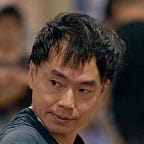Marimekko Tea House
A happy marriage of Finland with Japan
As part of the exhibition on Finnish pottery and Marimekko pattern design, I saw Marimekko Tea House at the Museum of Oriental Ceramics in Osaka today.
I have been learning tea ceremony for the past two years; I once learned about interior design; and I lived in Sweden for several years to have a first-hand experience of how Nordic design enriches our life. So I think I can say something about this tea house that other people won’t notice.
In a nutshell, Marimekko Tea House is the proof of the affinity between Nordic modern design and Japanese traditional culture.
First of all, the choice of fabric patterns transports the tea house into the nature. The exterior is decorated with pebbles on the riverside:
And the interior wall depicts the view of a swamp:
The whole idea of a tea house, dating from the 16th century in Japan, is to create a little pocket of the nature in the middle of a city. Here Marimekko’s pattern design assumes this historical role in Japanese culture.
And the Finnish textile brand’s signature pattern, Unikko, is reserved for casting the spotlight onto the tea master’s entrance into the room. In the photograph below, where we see the iconic Marimekko poppies:
That’s the entrance for the tea master to serve a cup of matcha tea for guests. When the guests arrive at the tea house, the arched sliding door is closed so that Unikko won’t be seen to the guests. Only when the tea master arrives by sliding the arched door open, the poppy flowers come into sight as the background for the tea-serving host who would be sitting on the floor with a bow. Then the door will be shut during the tea ceremony.
What a splendid piece of stage design!
The tea master himself or herself enters the tea house by opening the sliding screen decorated with Marimekko’s Hyasintti pattern:
Together with Unikko-filled walls, Marimekko’s colorful fabric will surely lift up the mood of the tea ceremony host during the preparation.
Marimekko Tea House demonstrates how cross-cultural collaboration, solidly rooted in the tradition on both sides (it’s fair to say that Marimekko has already become an institution in Finland), can spark into a powerful, totally new experience.
I have long been seeing the proximity between Nordic modern culture and Japanese traditional culture. Finally I saw the real proof of Nordic-Japan affinity.
A round of applause to Tetsuro Degawa (the director of the Museum of Oriental Ceramics in Osaka who initiated the project), Teruhito Iijima (the tea house architect) and, last but not least, Marimekko!
